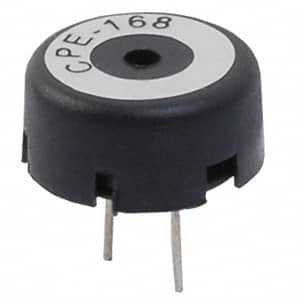Szczegóły produktu można znaleźć w specyfikacjach.

CPE-168 Product Overview
Introduction
CPE-168 is a versatile electronic component that belongs to the category of programmable logic devices. It is widely used in various electronic applications due to its flexibility and reconfigurability. This entry provides an in-depth overview of CPE-168, including its basic information, specifications, pin configuration, functional features, advantages, disadvantages, working principles, application field plans, and alternative models.
Basic Information Overview
- Category: Programmable Logic Devices
- Use: CPE-168 is utilized for implementing digital circuits and systems with reprogrammable functionality.
- Characteristics: It offers high flexibility, reconfigurability, and efficient utilization of resources.
- Package: CPE-168 is available in various package types, including QFP, BGA, and LQFP.
- Essence: The essence of CPE-168 lies in its ability to provide customizable logic functions for electronic applications.
- Packaging/Quantity: It is typically packaged in trays or reels, with quantities varying based on the specific manufacturer and distributor.
Specifications
CPE-168 specifications include: - Logic Capacity: Varies based on the specific model (e.g., 1000 to 5000 logic elements) - I/O Pins: Ranges from 50 to 200 pins - Operating Voltage: Typically 1.8V to 3.3V - Speed Grade: Available in different speed grades, such as -1, -2, -3
Detailed Pin Configuration
The detailed pin configuration of CPE-168 includes multiple I/O pins, power supply pins, configuration pins, and ground pins. The specific pinout varies depending on the package type and model variant.
Functional Features
- Reconfigurability: CPE-168 can be reprogrammed to implement different logic functions, allowing for flexibility in design.
- Embedded Memory: Some variants of CPE-168 feature embedded memory blocks for storing configuration data and user-defined functions.
- I/O Flexibility: It offers a range of I/O options to interface with external components and systems.
Advantages and Disadvantages
Advantages
- Flexibility in design
- Rapid prototyping and development
- Efficient resource utilization
Disadvantages
- Limited maximum operating frequency compared to dedicated ASICs
- Higher power consumption compared to low-power specialized devices
Working Principles
CPE-168 operates based on the principle of configurable logic, where the internal logic elements and interconnections can be programmed to realize custom digital functions. This is achieved through the use of configuration data that defines the behavior of the device.
Detailed Application Field Plans
CPE-168 finds extensive application in various fields, including: - Telecommunications: Used in networking equipment for protocol processing and traffic management. - Industrial Control: Employed in control systems for automation and monitoring. - Consumer Electronics: Integrated into consumer products for custom logic implementation.
Detailed and Complete Alternative Models
Several alternative models to CPE-168 are available in the market, including: - Altera MAX series - Xilinx Spartan series - Lattice Semiconductor iCE40 series
In conclusion, CPE-168 is a highly adaptable programmable logic device with diverse applications across different industries. Its reconfigurable nature and customizable features make it a valuable component in modern electronic designs.
Word Count: 410
Wymień 10 typowych pytań i odpowiedzi związanych z zastosowaniem CPE-168 w rozwiązaniach technicznych
What is CPE-168?
- CPE-168 stands for "Common Platform Enumeration" and is a standardized method for identifying and naming software applications, operating systems, and hardware devices.
How is CPE-168 used in technical solutions?
- CPE-168 is used to uniquely identify and categorize IT systems and components, making it easier to manage and secure them within technical solutions.
Why is CPE-168 important in technical solutions?
- CPE-168 provides a common language and framework for describing and referencing IT assets, which is crucial for effective asset management and security practices.
Can CPE-168 be integrated with existing IT management tools?
- Yes, CPE-168 can be integrated with various IT management tools and platforms to enhance asset tracking, vulnerability management, and configuration management.
How does CPE-168 impact vulnerability management?
- CPE-168 enables organizations to accurately identify and prioritize vulnerabilities across their IT infrastructure, leading to more effective remediation efforts.
Are there any limitations to using CPE-168 in technical solutions?
- While CPE-168 offers a standardized approach to asset identification, its effectiveness may depend on the completeness and accuracy of the CPE entries for specific products and versions.
Does CPE-168 support interoperability between different IT systems?
- Yes, CPE-168 facilitates interoperability by providing a common format for expressing and comparing system attributes across diverse environments.
How can CPE-168 help with compliance and auditing processes?
- CPE-168 simplifies the process of mapping IT assets to regulatory requirements and industry standards, streamlining compliance assessments and audits.
Is CPE-168 widely adopted in the industry?
- Yes, CPE-168 is recognized and utilized by many organizations, security vendors, and standardization bodies as a valuable tool for IT asset management and security.
What are some best practices for implementing CPE-168 in technical solutions?
- Best practices include maintaining an up-to-date CPE dictionary, integrating CPE-168 into vulnerability scanning and patch management processes, and leveraging CPE-168 data for risk assessment and incident response.

